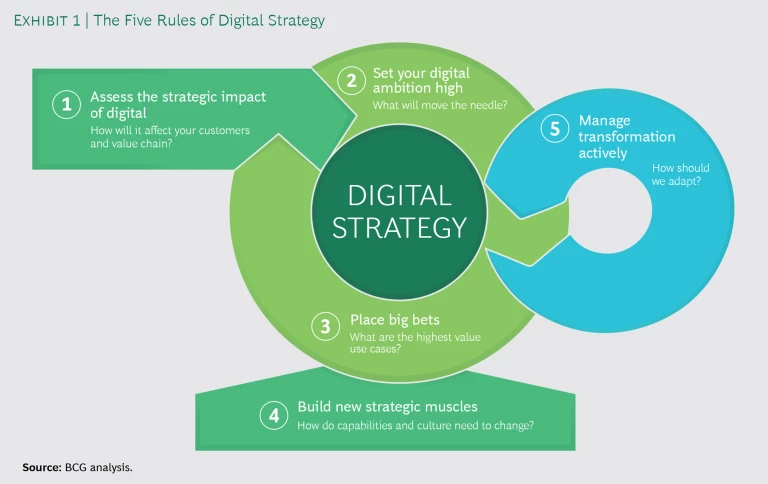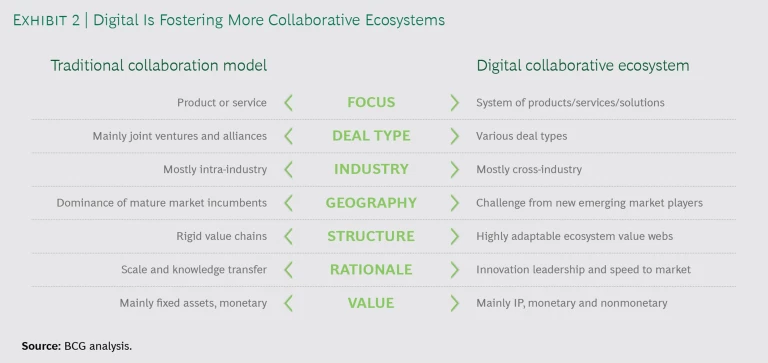A lot of ink has been spilled telling the stories of companies felled by digital disruption— think Kodak or Blockbuster. What gets far less attention is the way traditional incumbents are winning at the digital game. For companies like Starbucks, John Deere, and Unilever, digital is driving new sources of competitive advantage, growth, and value creation. Incumbents have huge advantages—resources, customer relationships, and global scale, to name just a few—that when tied to the right digital strategy give them the edge over smaller rivals.
In our experience, successful digital transformation must rest on a foundation of smart digital strategy. And smart digital strategy, like traditional business strategy, is about making wise investment choices to maximize competitive advantage, growth, profit, and value—and then implementing with discipline.
In many traditional industries, the digital winners’ circle is still up for grabs. Here are five rules for how to get the most from your digital strategy. (See Exhibit 1.)

1. Assess the Strategic Impact of Digital
Good digital strategy starts with a rich understanding of the competitive environment and how it’s likely to change. Because new technologies can radically reshape business economics, it’s essential to think through the implications for your own organization and your broader ecosystem of customers, suppliers, and partners. What new offerings can digital enable? What new competitors can it empower?
The impact and opportunities of digital will vary by industry and by function. Core business processes can be reinvented; for example, supply chains are being reconfigured thanks to Industry 4.0, making it possible to operate smaller, more flexible facilities closer to customers that can rapidly deliver new products tailored to local demand patterns. Digital platforms and their related ecosystems can offer access to borderless global markets—consider Airbnb. And digital services, often data driven, can radically enhance differentiation and lock in customers—think predictive maintenance offerings to increase uptime of aircraft.
The key is to open your mind to the full range of strategic possibilities—and risks—that digital brings. What are the essential technologies and their cost implications? What new capabilities could be required? What new and advantaged positions could you occupy in the future?
Consider Domino’s Pizza. Digital wouldn’t replace pizza, but the company realized that digital could strengthen its advantage in speed and convenience. Its consumer-facing mobile app streamlined the steps for ordering and receiving a pizza (and capturing happy-customer feedback). An interesting fact: Domino’s and Google both went public in 2004. If you’d invested a dollar in both, you’d have made more money with Domino’s.
2. Set Your Digital Ambition High
Organizations that win at digital start by thinking big—whether seeking to strengthen existing advantages or to tap new ones. The best digital strategies aspire to move the needle on value creation. This is especially true because in so many digital domains, network effects create winner-takes-all situations, in which first movers and smart fast followers have the edge.
Digital strategies fail more often because of too little ambition rather than too much. Kodak invented digital photography, and Blockbuster developed an online movie platform before Netflix did. But these historically successful, market-leading organizations starved those opportunities for funding and organizational focus because they prioritized their legacy businesses.

The coffee company Starbucks embraced digital to make up for lagging same-store sales. It found new ways for customers to order and pay for their coffee by developing a mobile payment app and rolling out digital loyalty programs. The result? Mobiles sales increased twice as fast as in-store sales.
The car manufacturer Renault set, and achieved, an explicit goal to drive a 25% increase in EBIT with its digital strategy. And it jumped in with both feet, running 15 pilots across all functions—from marketing through production—to understand where digital could give the greatest lift.
And keep in mind that digital strategies in many industries are increasingly also ecosystem strategies. Rarely does a company have in its organization all the necessary elements (expertise, intellectual property, customer access, and so on). (See Exhibit 2 for a list of the characteristics such ecosystems share.)
3. Place Big Bets
Where to start, and in what order? “Let a thousand flowers bloom” may make for nice landscaping, but it is bad strategy. In general, focusing on the two or three most valuable use cases lends greater clarity and delivers the best results.
It’s important to manage priority initiatives as a portfolio and roll out the ones with short-term impact first. Short-term wins (typically in areas like precision marketing, AI-driven pricing and promotion, and digitally driven cost reduction) will help fund the journey by freeing up capital and releasing resources needed for more strategic high-impact priorities down the road. A portfolio approach also makes it possible to demonstrate progress to key stakeholders: board members, investors, and the organization.
Focusing on the two or three most valuable use cases delivers the best results.
Unilever has invested decisively in digital across its value chain, with a particular strategic focus on harnessing data as an enterprise-wide asset that supports precision marketing, manufacturing, distribution, and performance management. The company captures 1.5 terabytes of data daily from more than 150 sources in its data lake—and plans to have 24 digital hubs in 24 countries by 2020.
In identifying the right set of bets, a customer-centric lens that focuses on both competitive advantage and value creation is critical. Ask: Of all the customer pain points and compromises that digital can address, which are we uniquely positioned to address, and of those, which have the greatest value potential?
John Deere, in its agricultural business, began with use cases anchored in the jobs farmers were trying to optimize: planting seeds optimally, adding just the right amount of nutrients, and putting the minimum amount of chemicals on their crops to prevent pests and weeds. This led to significant innovations—for example, the “see and spray” technology, which allows individual weeds to be identified through a combination of optical sensors and machine learning algorithms, and then killed through highly engineered and individually controlled spraying nozzles.
4. Build New Strategic Muscles
A properly ambitious digital strategy inevitably calls for new capabilities and cultural shifts. The organization needs to build new strategic muscles to complement its traditional strengths—and to ensure that new and old work together in an agile and coordinated way.
New digital talent is critical, but increasingly scarce. So just as important—and often underestimated—is redeploying existing talent and skills to the initiatives that can make the most of it. With both new and existing talent, think through what resources and capabilities can be shared across business units, divisions, or regions rather than that which needs to be dedicated to a single place. And develop a workforce that does not adhere to fixed roles, but evolves with the needs and pace of emerging digital initiatives. Don’t worry about defining an end-state organization at the outset—a multistage process that adapts on the basis of experience and digital maturity makes more sense.
Don’t worry about defining an end-state organization at the outset—a multistage process makes more sense.
Establishing a “digital” culture in these ways is essential to a successful digital strategy. It helps attract talent, particularly millennials, who are drawn to opportunities for autonomy and creativity. And because of the flatter organizational structure that comes from agile ways of working, companies can achieve superior results, faster than a traditional organization.
5. Manage Transformation Actively
While there is no need to completely rewrite the transformation rule book when it comes to digital, some issues will need your attention—such as the rate at which the critical underlying technologies for your industry are evolving, and thus how often you should revisit the underlying strategy to refresh the transformation plan.
Technological progress can be linear or discontinuous. In industries with slower-moving technologies, traditional top-down strategy development approaches work. But planning three years out can set you up for executional failure if changes in technologies and market dynamics shift more rapidly. In these faster-moving, more unpredictable industries, you will need a Fast Execution Needs Fast Strategy to planning, one that balances strategic alignment from above with market insight from below.
As with any organizational transformation, maintaining a strong center will be critical. That’s where program management lives, ensuring process standardization, data management, and talent acquisition. A transformation office, led by a chief digital transformation officer, can keep up the momentum, rigorously tracking progress against detailed goals, milestones, and metrics—and signal when it’s time to adjust course.
Not all digital transformations succeed. Those that do reflect a robust digital strategy that follows the five simple rules we’ve just described. They’ll ensure you get the most out of your people and digital investments by aligning them with the critical moves that drive competitive advantage and superior results.




